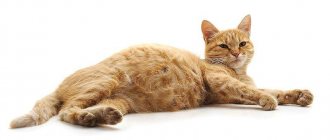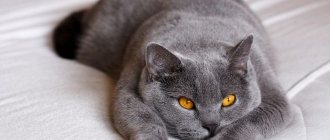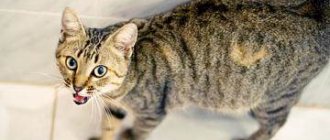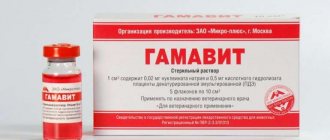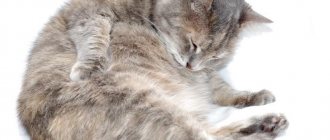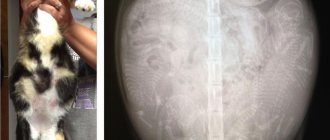Bearing and giving birth to kittens is an important stage in the life of both the cat and its owner. In order for everything to go as comfortably as possible and without harm to the expectant mother, you should calculate the birth date of the babies in advance.
Our online cat pregnancy and birth calculator will help with this. You will no longer have to get confused with notes on paper and make notes on the calendar. With our calculator you will definitely not make a mistake and will not miss a single detail.
How to determine if a cat is pregnant
If the owners consciously engaged in breeding, then they will not have problems determining pregnancy in the early stages. What you should pay attention to:
- two weeks after mating, the cat’s appetite increases;
- gradual weight gain occurs;
- nipples become darker and increase in size;
- toxicosis is rare, but it also happens. The pet may begin to vomit and have diarrhea;
- more aggressive behavior.
Pregnancy is a crucial period in the life of an animal
For your information! If a cat and a pregnant cat live together, the male may begin to show additional signs of attention to his chosen one and constantly protect her.
Puberty
British cats are called late breeders. Their puberty can take up to 11 months: each animal has its own developmental path. On average, plush pets mature at the age of 1 year. But in some children, initial signs appear at 4-5 months.
Estrus
The first heat of a British cat, according to the observations of British owners, begins at 7-9 months. During this period, inexperienced owners are lost and do not know what and how to help the animal. The cat screams, arches its back, raises its tail, and becomes restless. Experienced breeders know how long estrus lasts in cats of the British breed: it can last about 3 days to a week.
Recurrence of symptoms can be observed after 2 weeks if the animal is not taken for mating. The giving birth adult asks for attention from the male every three months. Don’t be afraid: the clinic’s specialists will explain how often British cats go into heat, or you can ask the owner of the cattery for advice.
It happens that the baby refuses to eat, loses weight, sheds intensely, and organizes concerts at night. Both the animal and family members suffer. Therefore, when planning to buy a British cat, you need to immediately decide: the pet is being taken for breeding or the owner does not intend to breed and, in the future, sell kittens.
How long does a cat's pregnancy last?
A cat's pregnancy lasts on average from 10 to 17 weeks. However, these indicators are relative, since animals, just like people, can bear a fetus longer or, conversely, less.
Dog pregnancy by day: details, table
However, prematurity and late labor can lead to unpleasant consequences. If kittens are born earlier than 10 weeks, there is a high probability that they will not be viable. If the gestation period exceeds 17 weeks, this may already threaten the health of the cat herself. In this case, she may need medical assistance to give birth safely.
It should be remembered that the future furry mother also requires a medical examination during pregnancy:
- to assess the general physical condition of the animal;
- calculate the cat's pregnancy calendar;
- find out the number of kittens;
- determine whether there is a need for medical assistance during childbirth. In rare cases, a cesarean section is even prescribed.
Important! If the owner has the opportunity, it will be better if the entire pregnancy period takes place under the supervision of a specialist, just like in humans.
Ultrasound
Childbearing age
During puberty, physiological changes occur in the kitten's body, after which it becomes capable of reproducing. The period of onset of childbearing age depends on the following factors:
- breed
- diet
- individual characteristics
- conditions of detention
Short-haired breeds, such as Britons and Siamese cats, mature earlier. Puberty occurs at the age of 5-6 months.
In long-haired and large cats, the first heat comes at 10-12 months.
The optimal age for procreation is from one to one and a half years. Cats give birth without harm to their health starting from the second or third heat.
Interesting to know
Theoretically, a cat can become pregnant at any reproductive age because estrus occurs throughout her life. There is a known case where a cat from Great Britain gave birth to two kittens at the age of 30.
How to determine the gestational age of a cat
A gradually increasing belly makes many owners nervous and worried. For greater peace of mind, you can keep a calendar until your cat gives birth. However, this method is suitable for those who approximately or exactly know the moment of conception.
Pregnancy of a Chihuahua by day and childbirth in a dog
Pregnancy is determined and significantly manifests itself already on days 16-18. The belly gradually grows, the nipples swell and become darker. The expectant mother's appetite increases, which undoubtedly affects her weight.
However, these are only visual signs that can tell the owner little. A pregnancy calculator can help you determine when your cat will give birth. Such programs are available on the Internet and are quite easy to use. However, the owner will also need information about the day of mating.
Important! If there is no information about conception, only a veterinarian can tell you a more precise date.
What is not allowed in an “interesting position”?
If the cat has been walking outside, then during gestation it should be fenced off from the street so that the cat does not get an infection or parasites.
You cannot overcool a cat or treat it with tablets and other means without consultation from a veterinary clinic. This can cause great harm to the offspring.
Don't let your cat get sick during pregnancy
The cat should be in a calm environment. Avoid stress. Surround with affection and care.
Monitor your cat's activity. She should not move too quickly, as there is a possibility of falling or colliding with some object, which could cause injury to both the cat and the fetus.
Cat pregnancy calendar by week
Development of kittens by week and by day after birth
Fetal development stages are most often indicated in weeks, and in the early stages days are used. Below we take a closer look at intrauterine development from the very first days.
Development by week
First week (0-7 days)
The embryo's cells divide but move freely throughout the uterus. Attachment to the wall occurs only 7-10 days after conception. This process is called implantation and the countdown begins with it. The online cat birth calculator also takes this period into account.
Second-third week (8-21 days)
The placenta is forming. Already on the 15th day, its formation is completed, and it is able to nourish and protect the embryo. The size of the future kitten is still very small. Outwardly, it looks like the letter C, but even in this form you can find the outlines of the future head and tail.
For your information! At this time, the first signs of pregnancy appear in the cat. The expectant mother becomes more capricious, picky, and may hide for a long time in a quiet, dark place.
Fourth week (22-28 days)
The fertilized egg increases to a size of 15-20 mm. At the moment, the cat embryo is difficult to distinguish from other mammals. The gradual development of internal organs, including the brain and heart, begins.
Important! An ultrasound at this stage shows a heartbeat of about 230 beats/min.
By the end of the 28th day, the baby’s paws, pads, and claws begin to form. The cat's behavior does not change during this period. Toxicosis may occur.
Fifth-sixth week (29-42 days)
At 5-6 weeks, sensory organs gradually form. As you know, cats have well-developed hearing and a sense of balance. Also at this stage, gradual preparation for growing a mustache occurs, and soft claws appear.
At this same stage, the nervous system and muscles develop. The child begins to actively move and push the mother cat. Most experts are inclined to believe that at this time the formation of the psyche ends, so it is worth paying great attention to the psychological comfort of a pregnant cat.
Seventh-eighth week (43-56 days)
The bones and spine are clearly visible on the x-ray. The fur is already fully formed. In general, on the 50th day, kittens are ready to be born, but this point also depends on the breed.
For example, the straight-eared British cat, Bengal, Maine Coon, and Scottish Fold grow a little slower than other members of the cat family and, accordingly, live longer. For this reason, you should not fit the pregnancy periods of sphinxes and “British” women into a single framework.
The ninth week is a harbinger of labor
The mother cat gradually begins to prepare for childbirth. The body shows the first symptoms, such as test contractions. The owner should carefully monitor the behavior, since in the prenatal state the pet is looking for a secluded place. It is also important not to create stressful situations for your pet and to feed it well.
Developed fetus
Week 10 (day 64 onwards)
By this time, those kittens that belong to the late breeds are already born. The cat's behavior during this period becomes calmer. The expectant mother expects the birth of her babies in a certain place, almost without leaving her bed.
Owners can purchase or make a special house for a cat. The main thing is that it is warm and closed from prying eyes.
Fetus at 13 weeks of gestation
For most cats that do not belong to certain breeds, the 13th week is already exceeding the norm. Further gestation can lead to the development of an overly large fetus, which can cause harm during childbirth.
Important! If the period has clearly exceeded the established period, it is better to seek help from a doctor.
Mating
Only purebred animals can be bred. The cat will not give birth: it is necessary to choose a doctor to sterilize the animal. Usually the procedure is performed after the end of the acute period of estrus. The client is given sedative drops to alleviate the condition. Important: do not use hormonal drugs that cause serious disturbances in your pet’s fragile body without a veterinarian’s prescription.
14 days before the event, it is necessary to give the cat anti-worm medications and check the pets for all necessary vaccinations. It is necessary to carry out hygiene procedures: trim the claws. It is not recommended to wash it just before mating: a household product will remove the natural odor of the animal.
When to breed
After the first heat begins, they skip another one and then only find a British cat for mating. It is forbidden to bring a gentleman without waiting for the right time, the third heat. The consequences of non-compliance with the rule are sad: a miscarriage may occur, kittens will be born weak or dead.
Choosing a partner
One of the important points in choosing a partner for mating is whether the British cat has experience. The animal must be suitable in age and size. External characteristics, color and color, advantages and disadvantages of the individual, compliance with the breed standard, take into account all the data. Pay attention to the absence of diseases in the cat; strong offspring are born from healthy parents. It is better to choose a cat from your club.
A British Shorthair cat should be bred to a British Shorthair cat. It is most often not recommended to take a long-haired cat for mating. In most structures, offspring are considered marriage. To participate in exhibitions, they will find out in which system the pet is registered.
How does mating work?
The successful outcome of mating British cats depends largely on the behavior of the girl. The fluffy beauty is taken to the male’s house, or to neutral territory. In his own home, the cat behaves more confidently, and the process will go faster.
If the ward does not like the partner, the mating does not work out. A girl can show aggression, bite a cat, scratch a person who is nearby. Such problems do not always happen, but they do occur during the first experience. And the owner must be prepared for such a situation and not leave his pet immediately after arriving at the British cat for mating.
When the female's behavior does not cause concern, it is necessary to leave the pets alone. The total period that animals spend mating lasts 2-3 days. After this time, the male usually loses interest in his partner.
Routine ultrasound during pregnancy
A specialist can prescribe an ultrasound scan at almost any time during pregnancy if the animal’s condition is in doubt. In the early stages, the owner can contact the veterinarian to confirm or deny the presence of pregnancy.
Next, the development of the fetus is monitored and the number of future kittens is determined. In any case, a visit to the veterinary clinic is recommended both for preventive purposes and if you experience feelings of anxiety about the condition of your pet.
Scheduled ultrasound
Complications
The most common complication of pregnancy in the Maine Coon breed is miscarriage. Reasons for this problem:
- rough treatment of a pet;
- poor quality and inadequate nutrition;
- hypothermia or dehydration;
- hormonal disbalance;
- infectious lesion.
In most cases, miscarriages occur in the 4th–5th week of pregnancy. If rejection occurs late in pregnancy, there is a high probability that dead fetuses will remain in the uterus. This is deadly for the female, so you need to take her to the veterinary clinic immediately.
After childbirth, due to excessive milk production, inflammation of the abdominal glands may occur. Mastitis can be identified by reddened and painful nipples, from which yellowish fluid flows. The cat will have to be protected from kittens; treatment is carried out using antibiotics.
When infection penetrates the uterus, metritis develops, accompanied by an increase in body temperature and the release of purulent fluid from the vulva. An infected pet is lethargic and nervous. Metritis is treated with antibiotic medications.
Caring for a pregnant cat
After giving birth, the cat does not require any special care. After making sure that everything is fine with the pet and newborn kittens, the person should leave them alone and quiet. The female is able to chew off the umbilical cord on her own and lick her babies.
The only important nuance regarding care is that in the future the bed will need to be changed periodically. And for a certain time, water and food (wet or easily digestible) should be kept next to the young mother.
For humans, cat birth is not something difficult or scary. In most cases, the animal itself knows what to do and how to behave. The main thing is to feed the pregnant cat well and provide her with peace.
Childbirth
Before the onset of labor, a British cat restlessly follows its owner, meows anxiously, and licks its fur. You need to be especially careful the day before the expected event. Within 12-14 hours, body temperature begins to drop to 37.9 °C. Before labor begins, it is necessary to study the main stages of the birth of babies.
As soon as contractions begin, you need to put her in a prepared box with a clean diaper. The crumbs appear at intervals of 40-60 minutes. Kittens are born in a bubble. The mother chews the shell and licks the cubs: it stimulates the respiratory function of newborns. After this, the cat chews the umbilical cord. The animal most often eats the delivered placenta.
The birth process lasts from 2 to 14 hours.
Why might there be few kittens?
Having studied the question of how many babies British breed cats give birth to for the first time, you may not be surprised at the appearance of one baby from a young favorite. In the first litter, 1-3 cubs are usually observed.
Why can there be many kittens?
Multiple births are transmitted through the female line and depend on the number of previous lambings. An adult cat that has given birth can produce more kittens, 4-5. Especially if she herself appeared as a result of a multiple pregnancy.
Different kittens from the same litter
Genetically identical babies may differ in color. Babies receive a different set of genes from their parents, which is why different kittens appear from the same litter.
First signs
The first signs of pregnancy appear approximately 3 weeks after the start of the last estrus. These include:
- Swelling of the cat's nipples (they become bright pink).
- Slight weight gain.
- No heat. The cat calms down and no longer asks for the cat.
- Changes in taste preferences (for example, the expectant mother begins to show interest in food to which she was previously indifferent, and vice versa).
There are no tests for feline pregnancy, but an interesting situation can be detected through ultrasound.
Toxicosis
The cause of toxicosis in cats is hormonal changes in the body, and in some cases, poor diet. Characteristic symptoms:
- Vomiting in the morning (has a light color and does not contain traces of blood or bile).
- Drowsiness and weakness.
- Increased nervousness.
- Decreased appetite.
- Unhealthy coat.
If you notice signs of toxicosis in a cat, you should not panic, because this is a normal physiological reaction to changes in hormonal levels. Toxicosis, as a rule, can be observed at 2 - 4 weeks of pregnancy, and it lasts on average about 10 days. Usually this condition does not require treatment and goes away on its own. But in case of prolonged toxicosis or significant deterioration of the condition, it is recommended to show the animal to a veterinarian.
